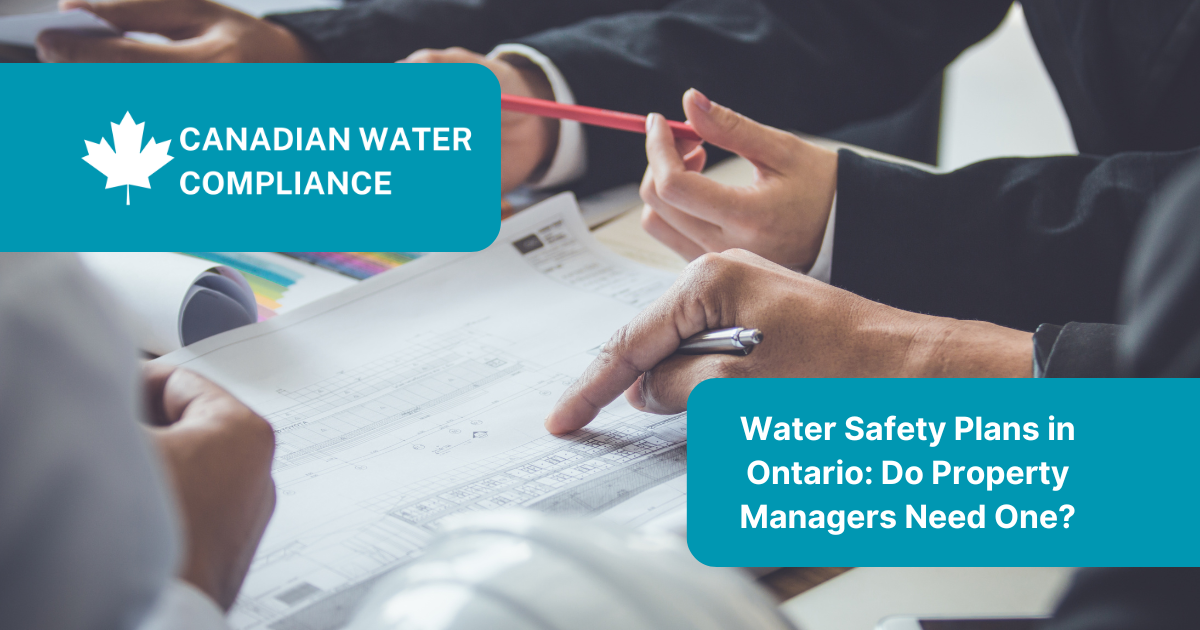
Written By: Canadian Water Compliance | On
Water safety plans (WSPs) are gaining recognition across Ontario as a critical risk management tool—especially for property owners and managers of buildings where water systems play an essential role. From cooling towers and domestic hot water systems to pools, spas, and potable water fixtures, a well-crafted water safety plan can help mitigate health risks, prevent outbreaks, and demonstrate due diligence.
But what exactly is a water safety plan? Do you need one? And what’s expected under Ontario’s current regulations?
Let’s break down what property managers and building owners in Ontario should know—and what best practices are recommended.
A Water Safety Plan is a comprehensive risk assessment and management approach developed by the World Health Organization (WHO) and increasingly adopted by regulatory bodies around the world. It involves:
Identifying potential hazards within a water system
Assessing the risks associated with those hazards
Implementing control measures to reduce or eliminate those risks
Ongoing monitoring and periodic review of the system
WSPs are particularly relevant for properties with complex water systems such as hospitals, long-term care facilities, large residential buildings, hotels, and recreational facilities.
While Ontario does not yet mandate full water safety plans for every building, the regulatory environment is shifting steadily in that direction. Several laws already require proactive water management practices that align with WSP principles:
This regulation requires regular testing of drinking water in certain types of facilities, including seasonal and non-municipal systems.
Outlines requirements for plumbing and water systems design, including cross-connection controls and backflow prevention—key risk points addressed in WSPs.
Long-term care homes and healthcare facilities must regularly test and maintain their water systems and have response protocols in place—again, echoing WSP structures.
Although there is no province-wide legislation for Legionella management in cooling towers, municipalities like Toronto and Hamilton have implemented guidelines, and a repeat outbreak—like the one in Orillia—can lead to lawsuits, as we've seen.
Failing to manage water safety properly can lead to serious legal and financial consequences. A notable example: the City of Orillia faced a $3.25 million lawsuit after a Legionella outbreak led to the death of a man in 2022. The lawsuit alleged the city failed to adequately inspect, maintain, or warn the public about risks associated with its cooling tower, even after a previous outbreak in 2019.
Negligence in these cases can result in:
Civil lawsuits for damages
Fines from regulatory bodies
Reputational harm
Loss of tenant or customer trust
Implementing a water safety plan helps demonstrate due diligence and proactive risk management—a strong legal defense if an incident occurs.
If you're a property manager or building owner in Ontario, here's how to stay ahead:
Conduct a Risk Assessment Identify all water-related systems (potable, HVAC, fountains, etc.) and assess potential hazards.
Create a Management Plan Define control measures such as regular flushing, temperature monitoring, biocide dosing, and sampling schedules.
Engage a Water Quality Expert Work with certified professionals who can assess your system and provide laboratory analysis of water samples.
Keep Records and Document Everything Maintain detailed logs of maintenance, testing, results, and corrective actions.
Update Your Plan Regularly Annual reviews or updates after system modifications are essential.
Canadian Water Compliance offers expert guidance in water safety planning for commercial, institutional, and residential buildings. We provide:
Certified water testing for Legionella, potable water, cooling towers, and more
Site-specific risk assessments
Ongoing testing and documentation support
Assistance in building your water safety plan from the ground up
By partnering with us, you’re not only safeguarding public health but also demonstrating regulatory responsibility and protecting your organization against liability.
While water safety plans aren’t legally required for every building in Ontario—yet—they are quickly becoming a recognized standard for responsible water management. With outbreaks and legal actions making headlines, proactive planning isn’t just smart—it’s necessary.
If you manage a property with water systems in Ontario, now is the time to assess your risk and implement controls. Contact Canadian Water Compliance today to learn how we can help you build and maintain a water safety plan that meets your needs.